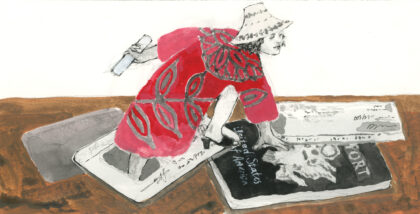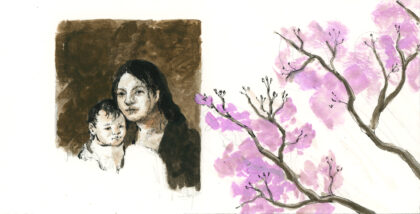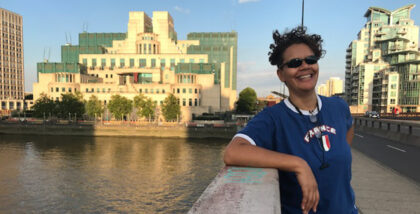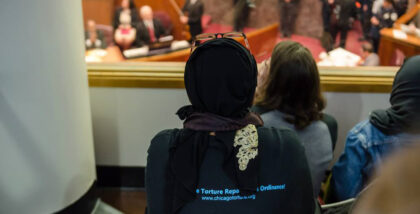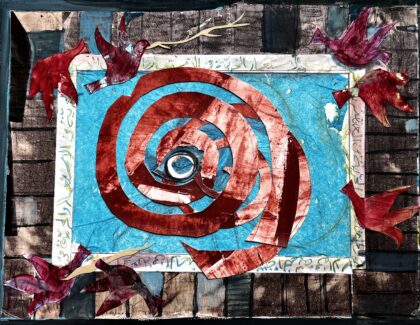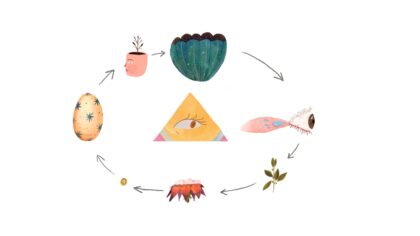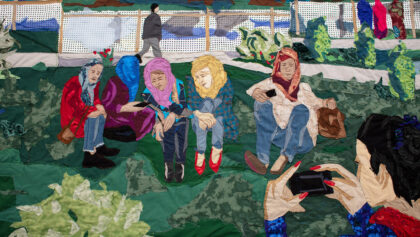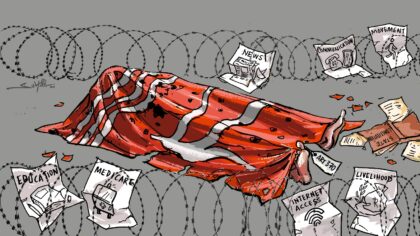 Illustration: Jia Sung
Illustration: Jia Sung
Samantha sits in a bright plastic chair just below a mosaic of Lady Guadalupe on the sanctuary wall of a sprawling church in San Ysidro, California. Slits of sunshine cut diagonally across the chair’s straight lines. In the faded image of the holy mother, a dark sash lays across her belly, indicating she is with child.
“Our Lady of Guadalupe is the mother of every single nation, country, and every single one of us. The son of God and the Mother of God—they are together. You can’t separate them. She intervenes for us.”
—Dr. Truc Truong (Vietnamese immigrant)
Samantha smiles at me as she sets down her chubby daughter, who reaches to grab my pen before waddling through the courtyard, dodging the deflated soccer ball a young boy had aimlessly kicked. Before telling me about herself, Samantha asks about me. I explain I was born in America after my parents fled Sri Lanka. “Oh, Sri Lanka,” she says, her face lighting up in recognition. “I met a very nice lady in detention, from Sri Lanka. She fought in the civil war.”
She begins her story with her parents. Her own mom was killed by state paramilitaries associated with the father she had never met. “Horrible. Horrible. Horrible.”: three times to conjure the hell of a motherless childhood in Honduras. A constant US military presence runs through her memories of home. “They were always there. Not just on the base. In the streets.” She never knew whether they were protective or predatory.
At eight months pregnant, when two lives were at imminent risk, she began to walk—towards the United States, seeking safety. Other young women separated from their mothers made a different choice. “The girls I knew from childhood, some of them,joined la Mara Salvatrucha (MS-13), for protection. They hated the United States.”
Moments of violence mark the map of her journey. “As I walked,” Samantha tells me, “I left more and more behind, until it was just me. Just me and the baby.”
***
I. Separate
adjective
*viewed as a unit apart or by itself
When my son was nine months old, we traveled to Sri Lanka. He was half as old as the recent defeat of the separatist Tamil Tigers by the government of Sri Lanka, and I was there to investigate crimes committed in the final stages of the bloody thirty-year conflict.
It wasn’t an easy task. Those affiliated with non-governmental organizations were barred from high-security zones. Journalists were detained. Government critics were forcefully silenced in the din of victory parades. Information came at a high price. Plus, I was a Tamil.
I was a lot of things: a scholar, a human rights researcher, a writer. Perhaps most viscerally, in the year that my body tried to reconstitute itself from predestined trauma, I was a mother.
I traveled up to the northern part of the island, where the earth was still freshly scorched, moving closer to an intimate violence. The sensitive cases, the weighted bellies that bore the burden of proof for mass rapes, were sent to a church. Military men lined the edges of the church courtyard. It was clear I wasn’t going to be able to walk right in.
Various guises to hide my identity were discussed: don a nun’s habit and pretend to be studying in the church; accompany a medical doctor; drop off baby bottles as a charitable donor. In the end, it was decided that the soldiers should see me carrying my son.
With Che in my arms, I was suddenly soft. I was just a mother—to be fleetingly separated from my actual, political self was the safest choice. The soldiers allowed me in.
*
Seven years later, I returned to Sri Lanka at a moment where activism and protest in the former warzones was beginning to timidly resurge.
Under a blue tarpaulin tent rimmed with gauzy saris, a group of Tamil mothers sit on two makeshift stages. It is their last of 500 days of protest demanding that the government release information on the children that never came home. Che has just turned eight years old. He wanders among them, my phone hanging perilously from his fingers, asking to take pictures.
Some women have fallen asleep in the shade cast across the wooden planks. They have grown used to repurposing saris for cover since their land was taken by the military. Waiting through the stillness of midday heat is familiar, too, from their months in internment camps.
My mother, visiting the homeland from America, asks Vasanthi, one of the “Mothers of the Disappeared,” “Will you accept the money the government is planning to give?” She had read in the local papers that reparations were the latest political platitude offered for their pain.
Vasanthi looks at me, then back at my mother. The response is sharp, “Will you take money for her, your child?” My mother left the island for her security and, eventually, mine. I wonder what traumas I have asked her to revisit in this moment.
Each mother has brought their favorite printed photograph of the child they once knew. The photos are first laminated and then wrapped in plastic bags: they are willing to use them, but they must be protected. Che comes over to sit on my lap: he has taken photos of their photos.
Their children did not disappear. They are detained or dead. Life, for the mothers, is framed in terms of death. Vasanthi says: “I only want to see my son before I die.” I visit her at home, where she has built a sort of mausoleum around her son’s material remains: a dusty stereo system, a faded gold trophy from a cricket match, an everyday sarong. She caresses the brand new sneakers he never wore.
Vasanthi’s pained face turns earnest, “You know, Nimmi, I have a very strong mind! I wanted to study politics. I could have, if not for the war.” She pauses. “My mind is very strong…” she repeats. She answers a question I didn’t ask: perhaps shielding herself against the cloak of victimization, perhaps feeling as though she is starting to lose her mind.
Vasanthi joined the Tigers to fight for the rights of her people. In a scolding tone, she explains, “I joined because the government was shelling our community and we were all scared. It was simple.”
In the collective of mothers, some of the women were combatants with the Tigers, and some were combatants in other rebel groups. Motherhood was a cultural cornerstone that cut both ways. A traditional Tamil mother fulfills her obligation to nurture her family inside the home; the Tigers extended that duty to the community, reinterpreting a mother’s role on the battlefield.
Then, as now, motherhood is simply a means to an end. Factions aside, Vasanthi explains, “If we organize as mothers, people have more sympathy.” In the hands of women acutely aware of the cultural commodity they wield, motherhood is a tool, sharpened to eke out the political space they have been denied. They are focused, she says, on diplomats from Europe.
“Why would we fall at the feet of the perpetrator to ask for our children back? We choose, instead, to fall at the feet of the witnesses. The ones who watched it happen.”
II. Separation Anxiety
*anxiety provoked in a young child by separation or the threat of separation from their mother.
Ana is on a student visa from Mexico at the City College of New York in Harlem. She decides to spend her summer in Dilley, Texas – supporting with case preparation and translation.
She remembers the chaos of legal triage at the border, being called to serve when a “native speaker” was shouted for.
As the cases build a reservoir of violence in her political memory she reflects,
“This process, is beyond separation of mother and child. It is the destruction of families, entire communities.”
In Dilley, Texas, a mother from Honduras is in the largest immigrant detention center in the US, preparing for the interview to determine whether her fear of home is credible. A guard knocks on the door with a wailing four-year-old. “He’s your son? He won’t stop crying.”
As she pulls the child on her lap, she explains that since he watched the guards pull children from their mothers, he won’t let her out of his sight. The temporary reunification seems to calm the child, and the officer returns to guard the other migrant children detained in a makeshift nursery.
She was an organizer for land rights in Honduras, the kind of political activity that will make the security forces zero in on their target. Nobody asks her about this.
*
In San Ysidro, California, the mothers wait to be heard.
As senior counsel at the ACLU of Southern California, Ahilan Arulanantham tells me, “You’re looking to create a set of positive valences for a judge.” An emotive appeal designed to draw the judge towards the intrinsic “goodness” of the client.
The story is crafted around the positive emotions that allow her in, burying the negative emotions that forced her out.
Courtrooms, for me, become an intensive course in policy and process: Credible Fear Interviews, “Catch and Release,” former Attorney General Jeff Sessions’s new ruling that rendered claims of domestic violence inadmissible.
Motherhood attracts sympathy; domestic violence elicits empathy. As the parts of the mother are parsed, and political selves are sliced off, the Judge hears a story that is simple—and sad.
*
“Horrible. Horrible. Horrible.”
All of the mothers’ stories are three parts horrible: Why She Left; The Journey; The Border.
In Sri Lanka, Devi was one of the early recruits to the Tigers, disrupting cultural expectations and taking up arms.
Negative Valence System
*Negative valence systems activate a pathway. Negative emotions associated with an aversive situation will determine an individual’s response, or judgment.
It was her neighbor’s son, first, that the military questioned and took away (potential threat). Devi’s own mother remembers hiding indoors from the riots, hoping the soldiers would pass her door (sustained threat). She lived every day with the anxiety that she would be separated from her only son. The fear was tangible. Then, it was her son who didn’t come home from school (acute threat).
Sympathetic Nervous System
* the part of the autonomic nervous system that is concerned with preparing the body to react to situations of stress or emergency, also known as the fight or flight response.
Once they were apart, the anxiety got worse.
Devi made a decision, to fight. She knew where to find them, the fatigued women who came home to pick the medicinal herbs in the garden needed to heal comrades. They would often sit on the swing and chat. She walked to the nearest training camp.
After years in the jungle, she knew they had lost before it was announced. She was in hiding, from the sounds. The gunfire could have been a helicopter, the helicopter could have been the backfire of a car. When she looks out into the darkness, people have started running. Muscle memory of trauma moves each leg as she runs on adrenaline.
If she is taken by government forces, she will be tortured—the fate she imagined for her son. This is why she left.
*
“As long as we live as slaves, this country will be filled with refugees and orphans. One day there will be freedom and my children will live free in that free land. Let them be orphans until then.”
—Vanathi, Tigers
The moment wasn’t as clear for Samantha in Honduras; the pressure built slowly as the violence of the streets came inside. When he hit her, she left their home. When he threatened the life of her unborn child, she left the neighborhood. When he pulled political strings that ran through the government to the arms of roaming militias, Samantha left the country.
On the journey, Devi and Samantha crossed paths unknowingly. Devi paid a middle man to fly her to Italy, where he raped her. Then she flew to Guatemala. Devi crossed much of Guatemala and Honduras on foot, navigating contested terrains with enterprising escorts entangled in local gang wars. When she arrived in the clinic of Our Lady of Guadalupe in Guadalajara, she was treated for scabies.
Information passed through caravans that the hospital was safe, the staff kind. The information reached Samantha months later. “I was so relieved to find them, to be able to give birth to my daughter inside the clinic.” For both, the temporary reprieves of the journey are embedded alongside the persistent violence.
*
The border is the sieve, separating the unwanted material from the stories that came before it. Violence by “coyotes” and “vultures” on the journey will be lost in transit; violence by protected militias will not be believed. In the heightened urgency of the first interview they will challenge the validity of her emotions: they will try to invalidate her fear.
In the church courtyard at the Mexico-California border, Samantha smiles easily, and often. “When they threw the frozen burritos at our feet, I was grateful.” She and her daughter hadn’t eaten for three days. She was certain once she made it to the border she would be free.
The entirety of her identity is collapsed into a nine-digit alien number. She waits in line for the showers to sterilize her. She joins the others, gathered in detention, now known as “the mothers.”
Even as they wait for their cases to be constructed, the border spins a story of its own.
*
A woman can be one of two things: a victim, or a threat.
The Judge has completed his implicit bias training; he is aware that her culture is different than his. He believes that he understands it and looks to her for confirmation.
“This is unacceptable. These mothers have fled some of the murder capitals of the world and fled domestic violence. And our government is treating them like they pose the same threat as a member of a transnational gang”
—Senator Kamala Harris
When allowed to speak, she will be asked to be complicit in his condemnation of her community, culture, an entire country (home) seen only through the guns the United States placed deep inside of it. The sparse testimony left behind is that of a threadbare mother stripped of the politics that pushed her out.
The Judge is also well-versed in asylum law: though the category of risk to life from political activity is a more likely bid for asylum, it does not apply here. Hers is the story of a victim, one that reaffirms his view of the world.
The judgment is positive, declared with ambivalence.
An ankle tracker is fitted to Samantha, a fixture more permanent than her status. She is no longer captive to an abusive husband, but beholden to a violent savior society.
In a previous life, Devi built a movement against a government; now she will never be separate from the state.
III. Separate
verb
*to cause to move or be apart
“A splintered self is being demanded of her. Unclear how to proceed, she resolves to shut out the world. She shrink wraps her vulnerability, becomes all rustle and shine, so see-through she is opaque.”
—Meena Kandasamy
Even over Skype, the hostility of the white-wigged judge in the British lower courts is palpable. As I begin to discuss the defendant’s political life, he cuts me off.
“That issue is separate,” he snaps. “We are discussing whether her life is at risk as a single mother.” This particular case was to determine the risk of return for “female-headed households,” mothers living alone in the military-heavy war zones in Sri Lanka.
The judge continues, with increasing animosity “Can you confirm that the defendant was not affiliated with the Tigers?” When a social movement emerges from an oppressed society, everyone is affiliated.
The details were different, but the case was always the same: The Native Woman vs. The Colonizer—the precedent set well before either the defendant or I were born.
In any asylum case you must first establish the peaceful nature of the defendant—that she is not a threat to the host country. Then, gruesome evidence verifies the violence that makes her a victim. Finally, you must prove that the violence is recurring and poses a threat to her life.
If she is a mother, the first task is infinitely easier. Motherhood transcends borders, party lines, and cultural differences. For juries and activists alike, the aggrieved mother is a deeply emotive cry to rally around a pure (not political) cause.
Revealing his desire to deport, he pushes further, “After the peace, isn’t life much better for women?” No. Not for the women who fought for a cause, the women who supported it, the women who lost.
I argue her innocence in the intractable conflict. I use data to determine the likelihood of rape by the military. I manipulate emotions with her motherhood. I select the negatives that might attract a positive determination.
Once the judge believes she is docile, sexualized, and morally sound, she is allowed to stay.
***
In the church courtyard, Samantha’s baby returns to check if we have anything new to offer her. Satisfied with a melting stick of string cheese, she stuffs it in her mouth and wanders off again.
“I knew, in Honduras, having a child would be giving the militias a kind of bait—as a mother they can take her from me, for political payback.” Samantha pauses. “At least here, in the United States, I know she will not be taken.”
“I thought, as a mother, the Judge at the border would have mercy on me.”
—Mother, Dilley Texas
Che calls twice as I sit with Samantha. I’ve left him 140 miles behind in Los Angeles with my mother. Counter to the expected pathways of development, he has transitioned from an easygoing toddler to a boy growing up inside the rise of anxiety in America. He recounts active shooter drills in school; marks moments of everyday racism; asks that his father and I sleep within shouting distance.
Samantha is waiting on the bus ticket that will take her to relatives in the Bronx, just to the east of where Che and I now live. Devi has joined the home of distant relatives in New Jersey just south of us.
When I meet her again, Devi tells me she thinks only of revenge.
“I will go back home, one day. I will do whatever I have to. I will find my son and the soldiers that did this to us.”


